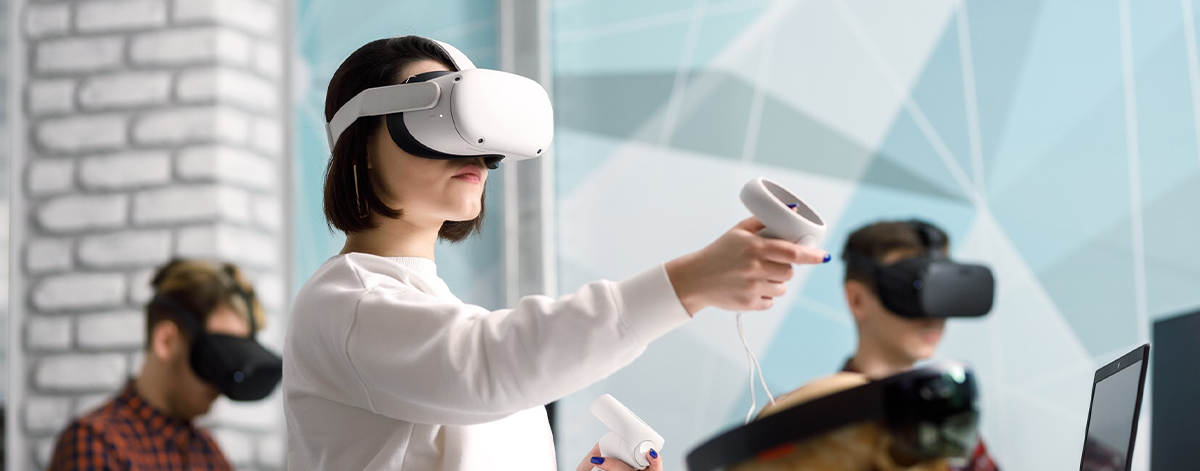
Workforce Transformation Through Learning and Development
October 31, 2025
Corporate eLearning Services: Building a Future-Ready Workforce
November 19, 2025Virtual reality learning is fundamentally changing how companies train their employees. It moves beyond generic how-to videos and classroom lectures. This technology creates realistic, simulated environments where users actively practice their skills.
The goal is simple: Achieve learning impact through a simulated experience. Virtual reality learning transforms the passive consumption of information into active engagement, making it one of the most effective tools for corporate development today.
What Is Virtual Reality Learning?
Virtual reality (VR) learning uses sophisticated technology such as head-mounted displays (HMDs), motion-tracking sensors, and haptic feedback systems to immerse a user in a computer-generated, three-dimensional (3D) world. This experience replicates real-world scenarios through realistic sights like detailed 3D graphics of machinery or hospital environments, spatial audio that simulates ambient sounds, and tactile feedback that mimics touch or resistance during simulated tasks.
The core definition of virtual reality is a highly collaborative 3D program. With the help of custom content and technology, it creates an immersion effect for the user. In the context of training, this means employees interact with a digitally rendered environment that visually and functionally mirrors their actual workplace. For example, a virtual construction site, an aircraft cockpit, or a hospital operating room, allowing them to perform real tasks in a simulated yet authentic setting. The environment is simulated, but the cognitive and behavioral learning is real. This high level of immersion is the key differentiator for modern corporate training.
Understanding VR-Based Learning Solutions: Types of Immersive Realities
Immersive learning is the umbrella term for technologies that create simulated, engaging training environments. VR-based learning solutions sit at the forefront of this movement. These solutions aren’t limited to one device or one specific type of reality.
Immersive learning leverages various technologies, often categorized by their level of immersion:
- Virtual Reality (VR): The user is fully encapsulated in a digital world. VR completely replicates the real environment. It requires a headset (HMD) and complete focus for practicing dangerous or highly technical procedures.
- Augmented Reality (AR): Digital elements are overlaid onto the real world. AR enhances the user's view of reality rather than replacing it. This is useful for on-the-job assistance such as maintenance technicians accessing digital instructions while looking at a machine.
- Mixed Reality (MR): This merges the real and virtual worlds, allowing users to interact with both physical and virtual objects simultaneously. It offers a sophisticated blend of real-world context and virtual simulation, often used for collaborative product design, medical procedures, or complex equipment assembly, where both precision and spatial awareness are critical.
VR-based learning solutions encompass all the above modalities, providing a versatile approach to upskilling a modern workforce.
The Benefits of Virtual Reality in Corporate Training
Integrating virtual reality learning into a corporate training strategy offers measurable advantages over traditional methods.
- Enhanced Safety and Risk Reduction
This is perhaps the most significant benefit. For industries like energy, construction, and healthcare, employees must handle challenging and risky tasks. VR allows them to make mistakes safely. Doctors can practice complex surgeries and engineers can troubleshoot dangerous equipment failures, all within a virtual environment. This dramatically decreases the potential for accidents and injuries in the actual workplace.
- Significant Cost-Effectiveness
Despite the initial investment in VR-based learning solutions, they’re long-term savings are substantial. VR eliminates costs associated with:
- Travel and Logistics: Employees don’t need to travel to a physical training facility.
- Infrastructure: No need for costly physical mock-ups, specialized classrooms, or equipment downtime.
- Material Waste: Physical training processes that use expensive or disposable materials are contained digitally in their VR versions.
- Increased Engagement and Retention
VR provides a distraction-free environment. Its immersive nature captures the learner's full attention, leading to higher focus and engagement during training. When learning is active and entertaining, retention rates skyrocket.
- Convenience and Scalability
Virtual reality learning makes training convenient. Employees can take courses at the point of need and at their own pace. For global organizations, VR training is highly scalable. The same high-quality, standardized experience can be instantly deployed to employees worldwide, ensuring consistency across all training programs.
Best Applications for Implementing VR-Based Learning Solutions in Your Workplace
While the benefits of VR are compelling, its true value is realized when applied to specific training needs.
- Safety and Compliance Training
One of the most impactful applications is safety and compliance training. Employees can be placed in simulated emergency scenarios such as fire outbreaks, chemical spills, or equipment malfunctions where they learn to respond effectively without real-world consequences. This not only improves preparedness but also ensures compliance with industry regulations.
- Technical Training
Technical training is another area where VR excels. Whether it’s operating heavy machinery, performing equipment maintenance, or assembling complex components, VR allows employees to practice tasks repeatedly until they master them. This is particularly useful in industries like automotive, aerospace, and manufacturing, where hands-on experience is essential but access to equipment may be limited.
- Soft Skills Training
Soft skills development also benefits from VR’s immersive capabilities. Through role-play simulations, employees can engage in customer interactions, conflict resolution, and leadership scenarios. These experiences help build emotional intelligence, communication skills, and decision-making abilities in a way that traditional workshops can’t replicate.
- Onboarding Training
Onboarding is another high-impact use case. New hires can explore virtual replicas of the workplace, understand company culture, and complete compliance modules—all before their first day on the job. This accelerates ramp-up time and creates a consistent onboarding experience across locations.
- Remote Team Enablement
For remote teams, VR bridges the geographical and experiential gap by offering immersive training that replicates in-person collaboration. Whether it’s a virtual factory tour or a simulated sales pitch, distributed employees receive the same quality of training as their on-site counterparts. This fosters inclusion and ensures that no team is left behind due to geography.
- Leadership Simulation Labs
Leadership and crisis management training is also gaining traction. Executives can be placed in high-pressure simulations, such as managing a PR crisis or navigating a strategic dilemma like deciding between two conflicting business expansion plans—where they practice decision-making, communication, and resilience under pressure. These scenarios prepare leaders for real-world challenges in a controlled, reflective environment.
- Product Knowledge Training
Finally, product and process training becomes more engaging with VR. Sales and service teams can interact with the virtual models of new products, explore features, and understand use cases—making them more confident and effective in customer interactions.
Each of these applications demonstrates how VR-based learning solutions can be embedded into everyday training programs to drive tangible results.
So, the evidence is clear: Virtual reality learning represents the critical transition point from academic knowledge to practical, job-ready competence. Traditional methods can explain what’s required, but only simulation based learning ensures an employee knows how to perform under pressure and respond correctly in high-stakes moments. This shift is not a temporary trend; it’s a permanent competitive imperative. By strategically deploying VR-based learning solutions, organizations immediately reduce operational risk, curb high training costs, and guarantee a highly proficient workforce. Investing in VR today is investing in future resilience and performance, moving your team beyond simple recall to true mastery.



